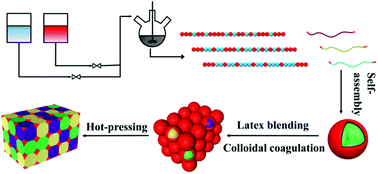Core–shell nano-latex blending method to prepare multi-shape memory polymers†
Abstract
Multi-shape memory polymers were prepared by blending a series of styrene (St)-block-(styrene-random-meth acrylate (MA))-block-styrene triblock copolymer nano-latexes. These latexes synthesized using a reversible addition-fragmentation chain transfer (RAFT) emulsion polymerization method have a core–shell structure. The cores are formed by the middle poly(St-random-MA) blocks. They act as transition phases with variable transition temperatures via adjusting the St/MA ratio. When the latexes are blended with an identical PSt shell but different poly(St-random-MA) cores, the shells play a role in preventing the aggregation of these poly(St-random-MA) cores forming a crosslinked network after hot-press treatment. Therefore a polymer with well-distributed multiple nanophases is achieved, which shows a quadruple-shape memory behavior. Furthermore, the shape memory and recovery performance at a certain temperature can be improved on purpose by increasing the mass ratio of the corresponding transition phases, which can be realized via simply varying the blending ratio of different latexes. An optimized multi-shape memory polymer with the shape memory and recovery ratio higher than 80% at all the transition temperatures is achieved.



 Please wait while we load your content...
Please wait while we load your content...